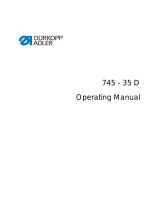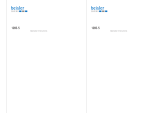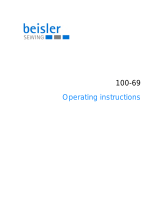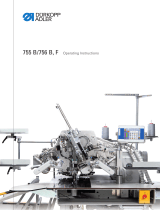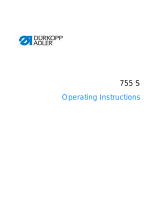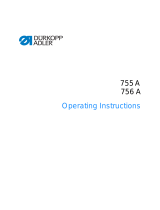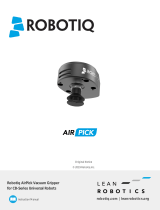Page is loading ...

Contents page:
Part 2: Installing instructions Kl. 745-26/ -28
1. Items supplied
. . . . . . . . . . . . . . . . . . . . . . . . . . . . . . . . . . . . . . . . . . . . 3
2. Setting up the sewing machine
. . . . . . . . . . . . . . . . . . . . . . . . . . . . . . . . . . . 3
2.1 Removing the carriage safety device . . . . . . . . . . . . . . . . . . . . . . . . . . . . . . . . . 3
2.2 Movement . . . . . . . . . . . . . . . . . . . . . . . . . . . . . . . . . . . . . . . . . . . . . . . . 4
2.3 Adjusting working height . . . . . . . . . . . . . . . . . . . . . . . . . . . . . . . . . . . . . . . 4
2.4 Checking V-belt tension . . . . . . . . . . . . . . . . . . . . . . . . . . . . . . . . . . . . . . . . 5
3. Attaching fitments removed for despatch
. . . . . . . . . . . . . . . . . . . . . . . . . . . . 6
3.1 Pedal . . . . . . . . . . . . . . . . . . . . . . . . . . . . . . . . . . . . . . . . . . . . . . . . . . 6
3.2 Thread pillar . . . . . . . . . . . . . . . . . . . . . . . . . . . . . . . . . . . . . . . . . . . . . . 7
3.3 Trays . . . . . . . . . . . . . . . . . . . . . . . . . . . . . . . . . . . . . . . . . . . . . . . . . . 7
3.4 Folder (working method A) . . . . . . . . . . . . . . . . . . . . . . . . . . . . . . . . . . . . . . 8
3.5 Folder and
gripper-folder (working methods B, C) . . . . . . . . . . . . . . . . . . . . . . . . . 8
3.6 Table wideners (accessories) . . . . . . . . . . . . . . . . . . . . . . . . . . . . . . . . . . . . . 10
3.7 Stacker (accessory) . . . . . . . . . . . . . . . . . . . . . . . . . . . . . . . . . . . . . . . . . . 11
3.8 Suction device (accessory) . . . . . . . . . . . . . . . . . . . . . . . . . . . . . . . . . . . . . . 12
4. Electrical connection
. . . . . . . . . . . . . . . . . . . . . . . . . . . . . . . . . . . . . . . . 13
4.1 Connecting the DAC operating panel . . . . . . . . . . . . . . . . . . . . . . . . . . . . . . . . 13
4.2 Checking rated voltage . . . . . . . . . . . . . . . . . . . . . . . . . . . . . . . . . . . . . . . . 14
4.3 Checking positioning . . . . . . . . . . . . . . . . . . . . . . . . . . . . . . . . . . . . . . . . . 15
5. Pneumatic connection
. . . . . . . . . . . . . . . . . . . . . . . . . . . . . . . . . . . . . . . . 16
6. Lubrication
. . . . . . . . . . . . . . . . . . . . . . . . . . . . . . . . . . . . . . . . . . . . . . 17
7. Starting up
. . . . . . . . . . . . . . . . . . . . . . . . . . . . . . . . . . . . . . . . . . . . . . . 18
Home

1. Items supplied
–
frame with DC motor for the upper machine assembly
–
stepping motors for handling material and for the longitudinal
adjustment of the trimming device
–
class 935-246-00 twin-needle double-lockstitch machine
745-26: with component set 0935 745304 for joint needle-bar
switching
745-28:with component set 0935 745307 for separate needle-bar
switching
–
DAC control device
–
reflex light barrier for flap sensing
–
two guide lamps for fabric placement
–
sewing lamp
–
compressed-air maintenance unit with compressed-air pistol
–
thread pillar
–
trays for items to be sewn on operator’s right and left
–
tools and hardware set
2. Setting up the sewing machine
Attention!
The sewing machine may only be set up by specialist trained
personnel.
2.1 Removing the carriage safety device
The carriage safety device 1 locks the carriage in its rearmost position.
It must be removed before the sewing machine is set up.
–
Remove the carriage safety device 1 after undoing the nuts.
1
3

2.2 Movement
The sewing-machine chassis is fitted with four castors for movement
around the plant.
Attention!
Prior to commissioning the sewing machine the sound absorbers 3 (in
the tools and hardware set) must be fitted to the four chassis supports.
Reverse the castors so that the machine is motionless and stable.
–
To move the machine extend the four castors by turning the
adjusting screws 2 to the left.
The chassis supports must have enough free floor space to allow
for movement.
–
After moving the sewing machine, lower it by turning the
adjustment screws 2 to the right.
All four chassis supports must be firmly on the floor.
2.3 Adjusting working height
Working height can be adjusted between 87 and 110 cm (measured to
the top of the table plate).
It is set to the minimum of 87 cm prior to despatch.
–
Undo locking screws 1 on all four spars of the chassis.
–
Adjust the base plate to the required working height.
To prevent the base plate from tilting, pull it out (or push it in) by
the same amount on both sides.
–
Tighten locking screws 1.
3
1
2
4

2.4 Checking V-belt tension
When the machine has been moved the V-belt tension (which is
pre-set prior to despatch) must be checked.
When the tension is correct it should be possible to depress the middle
of the V-belt 1 by about 10 mm by pressing on it with a finger.
Correcting V-belt tension:
–
undo screw 2
–
swivel sewing drive 3 until the required V-belt tension is produced
–
tighten screw 2
1
2
3
5

3. Attaching fitments removed for despatch
3.1 Pedal
Depending on the version, the sewing machine is equipped either with
a single pedal or with two (right and left).
The pedal 4 is attached to the lower cross-member 5:
–
Fix the pedal 4 to the lower cross-member 5 with the bracket 3.
The oblong slots in the bracket 3 enable the height to be slightly
adjusted.
Adjust the height of bracket 3 so that the pedal 4 can be easily
operated.
–
The second bracket 1 (supplied) acts as a support.
Attach bracket 1 as shown in the illustrations,
placing the four separator rings 2 between brackets 1 and 3.
–
Fit pedal linkage 6.
–
Slightly loosen locking screw 7.
–
Adjust the height of the pedal linkage 6 so that the pedal 4 is
horizontal when fully depressed.
–
Tighten locking screw 7.
1 2 3 4
5
6
3 5
6
7
6

3.4 Folder (working method A)
–
Place Folder
6 with span bearing 5 on the mounting bolt of locking
piece 1 as far as it will go.
The pin 3 must enter oblong slot 4.
–
Tighten locking screw 2.
The resulting setting will be as pre-set prior to despatch.
3.5 Folder and
gripper-folder (working method B, C)
Fixing the Folder
–
swivel folding unit away to the side
–
place Folder
3 on mounting 2
–
tighten locking screw 1.
Mounting 2 incorporates a centering hole.
Tightening the locking screw 1 automatically brings about the
correct setting.
3
4
5
6
1
2
1
2
3
8

Fixing the gripper-folder
–
swivel folding unit inwards
–
push gripper-folder with mounting 5 onto rod 7 as far as it will go
The pin 4 must enter oblong slot 3.
–
tighten locking screw 8
The resulting setting will be as pre-set prior to despatch.
–
Insert compressed-air connection 6 for needle spreading.
–
With working method C insert compressed-air connections 1 and 2
for braiding cutters.
6
7
8
1
2
3
4
5
9

3.6 Table wideners (accessories)
Table widener for trouser seats
(order no. 0794 002151)
–
Attach table widener 1 with screws 2 and the strap located behind
the frame member 3.
–
Slightly loosen the screws on the upper side of the table.
Push table widener 1 to create a gap between it and the table plate.
This gap is needed so that the pocket can pass freely through
once it has been placed in position.
Table widener for jacket fronts
(order no. 0794 002101)
–
Attach table widener 4 to support table with screws 5.
1 2
3
4
5
10

3.7 Stacker (accessory)
The throw-over stacker (Order no. Z112 427514) is attached to the
frame of the sewing unit with holder pipe 1.
At delivery of the sewing unit the holder pipe 1 is already premounted
on the frame brace 3.
If the throw-over stacker is delivered separately packed, the holder
pipe 1 must first be attached to the frame brace 3 of the sewing unit.
–
Mount guard plate 12 on the housing 11 of the throw-over stacker
with screws, washers and spring washers.
–
Fasten holder pipe 1 on the frame brace 3 of the sewing unit with
screws, washers and brackets 6.
–
Fasten spar 4 on the brace 5 of the stacker stand with screws,
washers and bracket 7.
–
Insert the ribbed plug 8 in spar 4.
–
Push the throw-over stacker toward the frame of the sewing unit so
that spar 4 catches in the holder pipe 1.
The height of spar 4 is adapted to the holder pipe 1 via the slots in
brace 5 of the stacker stand.
–
Insert the coupling plug of the compressed air feed into hose
coupling 10.
–
Insert the coupling plug of the control lead into hose coupling 9.
–
Attach one end of the potential cable 13 to the stopper plate 14 of
the throw-over stacker with the enclosed wing nut.
Attach the other end to the frame of the sewing unit with the
existing wing nut.
The potential cable 13 serves to conduct static charges to ground.
–
After starting the sewing unit with the throw-over stacker open, set
the clearance to the sewing unit.
The sewing pieces must securely enter the opening between the
smoother and the stacked-goods support.
–
Tighten clamping lever 2.
1 2 3 4 5
6 7 8
9
10
15
13
11
12
13
14
11

3.8 Suction device (accessory)
The suction device (order no. 0722 004282) facilitates the exact
positioning of materials on the working table.
Attention!
Do not reverse hoses 2 and 5.
Hose 2 must always be connected to pipe socket 6.
The pneumatically-operated air valve is fitted to pipe socket 6.
–
Lay hose 2 from the settling container 7 to the vacuum-connection
socket 1 of the sewing-machine table.
–
Connect compressed-air hose 3 from cylinder 4 of the air valve to
the Y41 solenoid valve.
–
Connect hose 5 to pipe socket 8 of settling container 7.
Connect other end of hose to on-site vacuum equipment or to the
centrifugal blower.
Note:
If there is no on-site vacuum equipment a centrifugal blower must
also be ordered.
Attention!
It is essential for filter bag 9 to be fitted beneath hose 5.
Filter bag 9 protects the vacuum generator from being penetrated by
dust and particles of dirt.
Hoses 2 and 5 must therefore on no account be swapped.
1
2
2 3 4 5
6 7 8
5
9
12

4. Electrical connection
Attention!
All work on the electrical equipment of the sewing machine must be
carried out by specialist electricians or other appropriately-trained
persons.
The mains plug must be removed.
4.1 Connecting the DAC operating panel
The DAC operating panel 1 is mounted on the right-hand side of the
machine, seen from the operator’s viewpoint.
–
Fit operating panel 1 with clamps 4 and 6 to attachment bracket 5
and adjust angle.
–
Firmly tighten clamping screws on clamps 4 and 6.
Attach potential cable 3 to clamp 4.
The function of the potential cable is to discharge static charges to
earth.
–
Slightly undo lock nut 7 on attachment bracket 5.
–
Rotate operating panel 1 until the operator has the best possible
view of the display.
–
Firmly tighten lock nut 7.
–
Carefully insert plug 2 into the back of the operating panel.
–
Tighten screws of plug 2.
1
2 3 4 5 6
7
13

4.2 Checking rated voltage
The rated voltage specified on the identification plate must coincide
with the mains voltage.
The sewing machine can be adapted to the local mains voltage by
means of terminals 1 to 5 on the transformer (see sketch).
The wiring for connection to 3-phase mains supplies is shown in the
terminal connection diagram.
If several DC drives are connected these should be uniformly
distributed over all phases.
3 - 2 : 190V
3 - 1 : 200V
4 - 2 : 210V
4 - 1 : 220V
5 - 2 : 230V
5 - 1 : 240V
230V
5 4 3 2 1
14

4.3 Checking positioning
Before the machine is started the positioning set prior to delivery
should be checked.
Once the main switch is turned on the sewing machine adopts the
thread-lever-up position.
Caution - danger of injury
Turn off the main switch.
Positioning should only be checked or adjusted with the main switch
turned off.
Checking positioning
–
Turn off the main switch.
–
Turn thread lever with handwheel to top dead centre position.
The thread lever must be just commencing its downward
movement.
–
In this position notch 2 on the positioning ring 1 must be in line
with notch 3 on the position indicator 5.
–
Adjust positioning if necessary.
Adjusting positioning
–
Undo clamping screws 4 on positioning ring 1.
–
Rotate positioning ring until notch 2 on it is in line with notch 3 on
position indicator 5.
–
Firmly tighten clamping screws 4.
1 2 3
4 5
15

5. Pneumatic connection
The sewing machine must have a supply of water-free compressed air
to operate its pneumatic components.
Attention!
For the pneumatic control processes to function properly the
compressed-air supply must be configured as follows:
Even when air consumption is at its peak the operating pressure must
not fall below
5 bar
.
If pressure fall-off is excessive:
–
increase compressor power
–
increase diameter of compressed-air lines.
Connecting compressed-air maintenance unit
–
Connect connection hose 1 (order no. 797 3031) to the
compressed-air supply with a R 1/4" hose connection.
Adjusting operating pressure
–
Operating pressure is
6 bar
.
It can be read off pressure gauge 3.
–
To adjust operating pressure lift and turn knob 2.
To increase pressure: turn clockwise
To decrease pressure: turn anti-clockwise
Attention!
No compressed air containing oil must be admitted from the air supply.
Clean compressed air is taken from behind the filter to clean machine
components and material by air-blasting.
Any oil droplets in the compressed air cause malfunctions and leave
marks on the material.
2
3
1
16

6. Lubrication
NB
Before starting the machine its upper assembly must be supplied with
oil.
The oil-supply container must be filled only with
ESSO SP-NK 10
lubricating oil.
SP-NK 10 can be obtained from
DÜRKOPP ADLER AG
sales outlets.
Oil-supply container 1 for upper-assembly lubrication
–
Fill oil-supply container 1 with oil through the holes in the sight
glass.
The oil level must be between the "Min." and "Max." marks.
Oil-supply container 3 for gripper lubrication
–
Move upper assembly of machine to one side.
–
Fill oil-supply container 3 with oil through nipple 2 up to the "Max."
mark.
1
2 3
2
3
17

7. Starting up
–
Turn on main switch.
Control is initialised.
The DÜRKOPP-ADLER logo briefly appears in the operating-panel
display.
–
The control unit checks whether the carriage is in its rearmost
position.
If not, "
<====REF
" (reference travel) appears in the display.
–
Depress left-hand pedal.
Reference travel commences.
The carriage moves to its rearmost position.
Reference travel is necessary to ensure that the carriage is always
in its defined starting position.
–
The display changes to the sewing-machine main screen.
–
By operating the appropriate pedals the various placement stages
are activated in sequence and sewing is commenced.
The individual stages depend on the working method and on the
configuration of the machine.
Attention!
At the commencement of sewing the material must be beneath the
feeding clamps.
Moving the carriage without material damages the covering of the
feeding clamps.
–
For the choice of sewing program and further control-unit
adjustment see part 4 ("DAC 745-26/-28: brief description").
–
Placement and operation are described in part 1 ("745-26/-28:
operating instructions").
<==== REF
18
/


